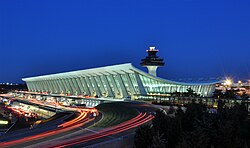Dulles International Airport

Washington Dulles International Airport (IATA: IAD, ICAO: KIAD, FAA LID: IAD), typically referred to as Dulles International Airport, Dulles Airport, Washington Dulles or simply Dulles ( DUL-iss), is an international airport in the Eastern United States, located in Loudoun County and Fairfax County in Virginia, 26 miles (42 km) west of Downtown Washington, D.C. Opened in 1962, it is named after John Foster Dulles (1888–1959), the 52nd U.S. Secretary of State who served under President Dwight D. Eisenhower. The Dulles main terminal is a well-known landmark designed by Eero Saarinen, who also designed the famous TWA terminal (now the TWA hotel) at New York's JFK airport. Operated by the Metropolitan Washington Airports Authority, Washington Dulles Airport occupies 13,000 acres (20.3 sq mi; 52.6 km2) straddling the Loudoun–Fairfax line. Most of the airport is in the unincorporated community of Dulles in Loudoun County, with a small portion in the unincorporated community of Chantilly in Fairfax County. Dulles is one of the three major airports in the larger Baltimore–Washington metropolitan area, the others being Reagan National Airport and Baltimore/Washington International Airport, and by land size and amount of facilities is the largest of the three. Dulles is considered the region's international air hub, with dozens of nonstop international flights. Dulles has the most international passenger traffic of any airport in the Mid-Atlantic outside the New York metropolitan area, including approximately 90% of the international passenger traffic in the Baltimore–Washington region. It had more than 20 million passenger enplanements every year from 2004 to 2019, with 24 million enplanements in 2019. On a typical day, more than 60,000 passengers pass through Dulles to and from more than 125 destinations around the world.Increased domestic travel from Reagan National Airport has eroded some of Dulles's domestic routes. Dulles overtook Reagan in total enplanements in 2019. However, in 2018, Dulles Airport surpassed Ronald Reagan Washington National Airport (DCA) in yearly passenger boardings after having fewer passengers since 2015. Furthermore, it still ranks behind Baltimore/Washington International Thurgood Marshall Airport (BWI) in total annual passenger boardings.Dulles is a hub for United Airlines and is frequently used by airlines which United has codeshare agreements with, mostly composed of Star Alliance members like Turkish Airlines and Lufthansa.
Excerpt from the Wikipedia article Dulles International Airport (License: CC BY-SA 3.0, Authors, Images).Dulles International Airport
West Service Road,
Geographical coordinates (GPS) Address Nearby Places Show on map
Geographical coordinates (GPS)
| Latitude | Longitude |
|---|---|
| N 38.944444444444 ° | E -77.455833333333 ° |
Address
West Service Road
West Service Road
20102
Virginia, United States
Open on Google Maps






